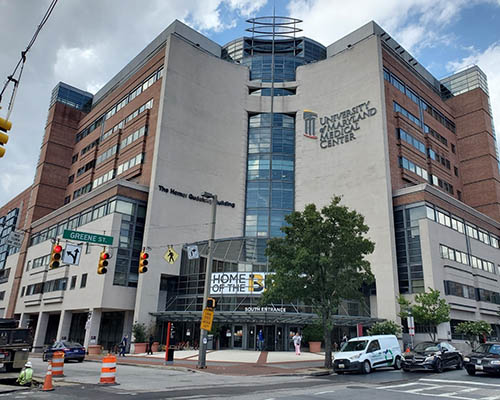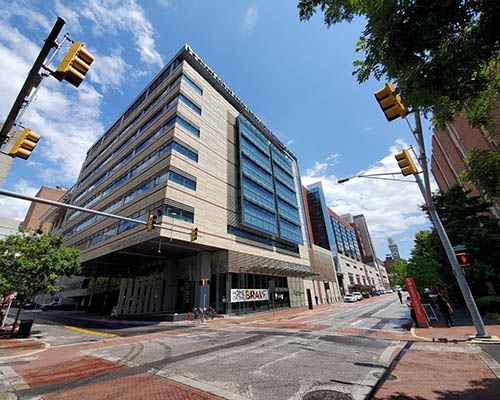Facilities - Critical Care Medicine Fellowship

The Critical Care Medicine Fellowship is embedded within the Pulmonary and Critical Care Division of the Department of Medicine. This provides a comprehensive training program that utilizes the resources of the Division as well as other Departments on the University of Maryland Baltimore campus. The three major facilities in which our fellows train are the University of Maryland Medical Center (UMMC), R Adams Cowley Shock Trauma, and the UMMC Midtown Medical Center.
The University of Maryland Medical Center is a major quaternary and primary care facility. Doctors, nurses, students, clinical pharmacists, and support staff work as a team to promote unified and comprehensive care for every patient.
There are multiple medical teams at UMMC and numerous critical care units, including the Medical Intensive Care Unit (MICU), Coronary Care Unit (CCU), Cardiac Surgery ICU (CSICU), Surgery ICU (SICU), Neurologic ICU, and others within the Maryland Shock Trauma Center.
Many of these units have step-down units (IMC) as well. Several specialty areas are located within UMMC, including the Bone Marrow Transplant Unit and the Greenebaum Cancer Center. Medicine residents provide patient care under the direct supervision of faculty, and subspecialty fellows serve as consultants and participate in specialized care. View the main hospital us on a video tour.
R Adams Cowley Shock Trauma Center
The R Adams Cowley Shock Trauma Center, the nation's first and only integrated trauma hospital, is dedicated to treating the critically ill and severely injured, and employs groundbreaking research and innovative medical procedures with one goal in mind—saving lives. As one of the highest volume trauma centers in the United States, teams of providers are standing by 24/7 to receive, resuscitate, stabilize, and treat those whose lives are threatened by time-sensitive injury and illness including, but not limited to thoracic, intra-abdominal, and facial trauma; spinal cord and column injuries; brain injury; and acute complex orthopedic injury. In addition, patients who develop life-threatening respiratory failure, multiple organ dysfunction, soft tissue infection, and sepsis may be transferred to the Shock Trauma Center where expert clinicians and sophisticated technology such as advanced hemodynamic monitoring, continuous renal replacement therapy, and extracorporeal membrane oxygenation are readily available.

The Shock Trauma Center is a multidisciplinary clinical, educational, and research institution dedicated to world-class standards in the prevention and management of critical injury and illness. Its highly specialized medical personnel and dedicated resources are focused on a single mission: To eradicate preventable death and disability and thus reduce the personal tragedy and overall costs associated with severe injury. This mission is continuously pursued through state-of-the-art clinical care services, active research, didactic and hands-on clinical education, and prevention programs.
The Trauma Center’s physical plant covers 340,000 square feet, including the expanded Critical Care Tower. The Trauma Center is designed to ensure immediate diagnostic and therapeutic access for critically injured and ill patients. Key features include:
- A dedicated, highly trained, and experienced multidisciplinary clinical staff
- A dedicated ground entrance for ambulances
- Rooftop helipad capable of handling four helicopters simultaneously
- A dedicated trauma resuscitation unit with 13 resuscitation/stabilization bays
- 10 state-of-the-art operating rooms and 12 post-anesthesia recovery beds
- 24 critical care/intensive care beds, 24 intermediate care beds, 12 acute care beds with the capacity for additional beds on an as-needed basis in the adjacent University of Maryland Medical Center
- Neurotrauma unit consisting of 14 critical care beds and 20 intermediate care beds
- Critical Care Resuscitation Unit with 6 dedicated beds
- Lung Rescue Unit with 6 dedicated beds.
- Comprehensive radiology service and the Mirmiran Foundation Diagnostic Imaging Suite with two dedicated high-speed computed tomography (CT) scanners and trauma angiography suite, all accessible 24 hours a day
- Sophisticated technological monitoring and clinical computer capability at the bedside
- A multi-patient hyperbaric chamber
- A trauma and specialty care ambulatory center with 14 exam rooms
- Respiratory, physical, occupational, and speech therapy services; case management; pain management; integrative medicine; nutritional services; social work and pastoral care staff; designated patient advocate; and substance abuse program
Shock Trauma continues to be the nation’s premier trauma center, advancing care and developing new life-saving techniques. It also serves as a referral center for Maryland in neurotrauma and hyperbaric medicine.
UMMC Midtown Medical Center
Located in Baltimore a few minutes from the primary UMMC Medical Center, the UMMC Midtown Campus is a 200-bed non-profit, community teaching hospital. In 1999, the Midtown Medical Center became part of the University of Maryland Medical System. The Midtown campus provides care in more than 30 medical specialties and serves about 100,000 patients each year. In 2010, a new facility was opened which includes state-of-the-art operating suites, an 18-bed intensive care unit, a new Sleep Disorders Center, and a new Post-Acute Specialty Program (PASP) and Pulmonary Rehabilitation Program. The UMMC Midtown Campus has continued to grow and expand its services over the past few years as part of its ongoing commitment to support the health of the Baltimore community. The new Outpatient Tower will be opening in late 2021.
